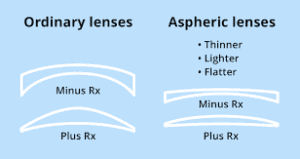Choosing The Right Lens Material
There was a time when all eye glass lenses were made out of glass.
Plastic lenses were first introduced in the 1940’s because even though glass lenses have very good optical quality, they are very heavy and look very thick.
Plastic lenses are more comfortable. They are lighter than glass lenses and are now the lenses of choice around the world. In recent years thinner materials have been created.
They are called high index lenses. These lenses provide a thinner and more attractive look than regular lenses of the same prescription power.
They are available in both glass and plastic.
High index lenses are so called because they have a higher refractive index than regular glass or plastic.
This is a measure of how effectively a lens material can bend light. The superior lens-bending qualities allow high index lenses to be made thinner than lenses made of regular glass or plastic, which have a lower refractive index.
 Most lens materials currently sold around the world, range in index from 1.50 (regular plastic) to 1.74 index. 1.74 being the thinnest lens.
Most lens materials currently sold around the world, range in index from 1.50 (regular plastic) to 1.74 index. 1.74 being the thinnest lens.
When looking for high index plastic lenses, one should look for those that have an aspheric design.
Aspheric lenses have flatter curves than traditional glass or plastic lenses, making them look even more slimmer and more attractive.
Polycarbonate and Trivex lenses are also an alternative to regular high index lenses.
A number of other factors that can influence the weight, overall thickness and optical performance of eyeglass lenses are the center thickness of the lens, the edge thickness of the lens, the lens design, and the size and shape of the frame one selects.
Look out for the next post where we dig deeper and provide you with hands on tips on frame and lens materials.
“REMEMBER TO KEEP AN EYE ON YOUR EYES”
- 10 SIGNS YOU NEED AN EYE EXAM - May 20, 2018
- WORLD GLAUCOMA WEEK - March 11, 2018
- The Importance OfEye Exams - February 5, 2018


Recent Comments